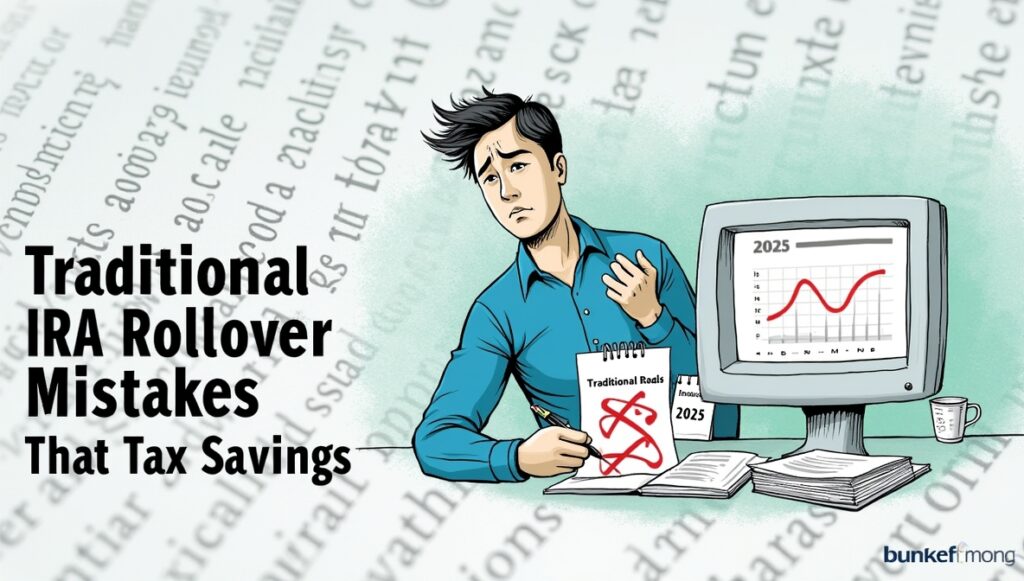
When people plan for retirement, they often move money from one account to another. One common way to do this is with a Traditional IRA rollover. A rollover can be a smart way to keep money growing without paying taxes right away. But, if you make mistakes during the process, you could lose thousands of dollars in tax savings. That’s why it is important to know what to avoid. In this article, we’ll look at the biggest errors people make, how those mistakes affect tax saving investments, and how to protect your hard-earned money.
What common rollover errors cost taxpayers thousands in lost tax savings?
Doing a Traditional IRA rollover sounds simple, but many small mistakes can create huge problems. Some of these errors can cause unexpected taxes or even penalties from the IRS. If you want your tax saving investments to work as planned, you’ll want to avoid the following issues.
Mistake 1: Taking the Money Out Yourself
One of the most common mistakes happens when someone takes the money from their retirement account into their own hands. For example, let’s say you leave your job and decide to move your 401(k) into a Traditional IRA. If the check is made out to you instead of directly to the new account, the IRS may treat it like you withdrew the money.
Here’s what happens:
- The company holding your account must withhold 20% for federal taxes.
- If you don’t put the full amount into the new account within 60 days, you’ll owe income tax on that money.
- If you are under 59½, you may also get hit with a 10% early withdrawal penalty.
This simple error can ruin years of tax savings and reduce the growth of your retirement account. The safer option is called a “direct rollover.” With a direct rollover, the money goes straight from your old account to your new IRA, avoiding the tax trap.
Mistake 2: Missing the 60-Day Deadline
Even if you do take the money yourself, the IRS gives you 60 days to put it into another Traditional IRA. Miss this deadline, and the entire amount counts as income. For many people, that can mean thousands of dollars in taxes in a single year.
Imagine saving for decades and then losing a chunk of your savings just because you missed a date on the calendar. The 60-day rule is strict, and while there are rare cases where the IRS grants exceptions, you should never rely on that. If you want to keep your tax saving investments safe, plan ahead and don’t cut it close.
Mistake 3: Mixing After-Tax and Pre-Tax Money
Traditional IRAs usually contain pre-tax money, meaning you haven’t paid taxes on it yet. But sometimes people also add after-tax money. When you roll over funds that include both types, you must carefully track what is pre-tax and what is after-tax.
If you mix them up, you could end up paying tax twice on the same money. The IRS uses something called the “pro-rata rule” to figure out how much of your rollover is taxable. If you don’t keep records or get advice, you may lose valuable tax savings without even realizing it. A good rule of thumb is to keep after-tax money in a separate account or speak with a tax advisor before rolling over.
Mistake 4: Doing Too Many Rollovers
Here’s another surprise: you can only do one IRA-to-IRA rollover per year. Some people think they can move money back and forth as much as they want, but the IRS has strict limits. If you try to do more than one in a 12-month period, the extra rollovers may be treated as taxable income.
Even worse, if you try to put the extra money back into your IRA, it may be seen as an “excess contribution.” That can bring even more penalties. This mistake is easy to avoid if you plan ahead. Remember, the one-per-year rule applies to Traditional IRAs, not to direct transfers from employer plans like 401(k)s.
Mistake 5: Forgetting About Employer Plan Rules
Not all retirement accounts follow the same rules. Some employer plans, like a 401(k), may have special conditions for rollovers. For example, some plans don’t allow partial rollovers, while others may have unique tax reporting steps.
If you don’t read the fine print or ask questions, you could miss important details. Always check with your employer or plan administrator before moving money. This step protects your tax saving investments and ensures you don’t get an unpleasant surprise later.
Mistake 6: Overlooking Required Minimum Distributions (RMDs)
When you reach age 73, the IRS requires you to take out a certain amount of money each year from your Traditional IRA or 401(k). These are called Required Minimum Distributions (RMDs). If you try to roll over your entire account, including money that should have been taken as an RMD, you’ll make a costly mistake.
The IRS doesn’t allow RMDs to be rolled over. If you do, the amount could be considered an excess contribution and taxed again. On top of that, failing to take an RMD comes with one of the harshest penalties in the tax code, up to 25% of the amount you should have taken out.
To protect your tax savings, always separate your RMD from the rollover.
Mistake 7: Ignoring Professional Advice
Perhaps the biggest mistake is thinking you can handle everything on your own. Retirement rollovers involve many rules, and even small errors can create large tax bills. While it may cost money to hire a financial advisor or tax professional, the savings often outweigh the cost.
An advisor can help you:
- Understand the difference between direct and indirect rollovers.
- Avoid penalties linked to the 60-day rule.
- Track after-tax contributions correctly.
- Stay within the one-per-year rollover limit.
By getting advice, you keep your Traditional IRA rollover working the way it should, protecting your tax savings for years to come.
How to Protect Your Tax Savings
Now that we’ve looked at the main mistakes, here are some simple steps to keep your tax saving investments safe:
- Choose a direct rollover whenever possible.
This avoids most of the common tax problems. - Mark important deadlines.
If you’re handling funds yourself, set reminders so you don’t miss the 60-day limit. - Keep careful records.
Write down what money is pre-tax and what is after-tax. - Talk to professionals.
Tax rules change, and expert advice can save you from costly errors. - Know the one-rollover-per-year rule.
Plan transfers carefully so you don’t break the rule. - Understand RMDs.
Once you hit age 73, separate these from any rollover plans.
By following these steps, you can enjoy the growth of your retirement savings without losing money to unnecessary taxes.
Final Thoughts
A Traditional IRA rollover can be one of the best ways to protect your retirement money and keep it growing tax-deferred. But small mistakes can turn what should be a smart move into a financial disaster. The errors we’ve covered, taking money out yourself, missing the 60-day deadline, mixing after-tax and pre-tax dollars, doing too many rollovers, forgetting about RMDs, or ignoring employer rules, can all destroy valuable tax savings.
If you’re careful and ask for help when needed, you’ll avoid these pitfalls. That way, your tax saving investments can continue working for you, and you’ll keep more of your hard-earned money for retirement.
Remember: the goal of saving is not just to build wealth, but to keep it. Avoiding rollover mistakes is one of the smartest moves you can make in 2025 and beyond.


